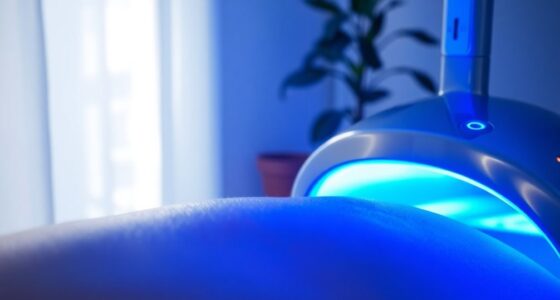Light therapy is an effective, non-drug method for improving sleep, mood, and behavior in Alzheimer’s and elderly individuals. By exposing yourself to bright, blue-enriched light in the morning for 30 minutes to an hour, you help reset their internal clock and promote better sleep cycles. Proper timing and routine are key, and minimizing evening blue light can enhance results. Keep exploring to discover how to optimize this therapy for your loved ones’ well-being.
Key Takeaways
- Light therapy improves sleep quality, mood, and alertness in Alzheimer’s and elderly populations by regulating circadian rhythms.
- Morning exposure to bright, blue-enriched light effectively resets internal clocks and enhances melatonin production.
- Proper timing and intensity of light exposure are crucial for maximizing therapeutic benefits and minimizing disruptions.
- Regular use of specialized light boxes supports circadian alignment, potentially slowing cognitive decline and reducing agitation.
- Research indicates that light therapy is a safe, non-pharmacological approach that promotes overall well-being in elderly and dementia patients.

Light therapy has gained recognition as a promising non-pharmacological treatment for improving the quality of life in individuals with Alzheimer’s and other elderly populations. Its primary mechanism involves influencing circadian regulation, which helps synchronize the body’s internal clock with the external environment. As you age, your circadian rhythms tend to become disrupted, leading to sleep disturbances, daytime drowsiness, and mood fluctuations. By exposing yourself to specific wavelengths and intensities of light at strategic times, you can support your natural biological rhythms and promote a healthier sleep-wake cycle. This is particularly important for those with Alzheimer’s, where circadian misalignment often exacerbates cognitive decline and behavioral issues.
One of the key ways light therapy works is by enhancing melatonin production. Melatonin is a hormone that your body naturally produces in response to darkness, signaling that it’s time to sleep. In older adults, especially those with Alzheimer’s, melatonin production can decrease or become irregular, resulting in difficulties falling asleep and poor sleep quality. When you receive proper light exposure during the day, particularly bright, blue-enriched light, it helps reset your internal clock, encouraging your brain to produce melatonin at appropriate times in the evening. This regulation not only improves sleep but also stabilizes your mood and reduces agitation often associated with dementia.
Timing and intensity are vital factors in effective light therapy. You’ll want to receive bright light exposure in the morning hours, ideally for about 30 minutes to an hour, using specialized light boxes designed for therapeutic purposes. This morning light acts as a cue to your circadian system, reinforcing the natural cycle and boosting melatonin production during the night. Conversely, minimizing exposure to artificial light in the evening, especially blue light from screens, can support your body’s ability to produce melatonin naturally. As you integrate light therapy into your routine, you may notice improvements in sleep patterns, increased alertness during the day, and a more stable mood.
Frequently Asked Questions
How Does Light Therapy Compare to Medication for Alzheimer’s Symptoms?
You’ll find that light therapy offers a promising alternative treatment for Alzheimer’s symptoms, often with fewer side effects than medication. While medication can provide symptom relief, its effectiveness varies and may cause unwanted effects. Light therapy, on the other hand, can improve sleep and mood, enhancing overall well-being. Combining both approaches might be beneficial, but light therapy’s non-invasive nature makes it a compelling option to explore for symptom management.
Are There Any Risks or Side Effects Associated With Light Therapy?
You might worry about potential side effects, but light therapy is generally safe when used properly. Risks are minimal, mainly including eye strain or mild headaches, and these can often be avoided with appropriate safety precautions like proper light intensity and duration. Always consult a healthcare professional to confirm safety, especially for those with eye conditions or skin sensitivities, so you can confidently incorporate light therapy into care routines.
What Types of Light Are Most Effective for Elderly Care?
You’ll find LED lighting and natural sunlight most effective for elderly care. LED lights provide consistent, adjustable brightness that mimics natural daylight, helping regulate circadian rhythms. Spending time outdoors or near windows allows seniors to absorb natural sunlight, which boosts mood and improves sleep. Combining both types ensures maximum benefits, supporting overall well-being and cognitive function. Make sure to tailor lighting to individual needs for the best outcomes.
How Long Does It Typically Take to See Results From Light Therapy?
You can typically expect to see results from light therapy within 1 to 3 weeks, depending on individual response. The timing expectations vary, but consistent therapy duration—usually 30 minutes daily—helps optimize benefits. Keep in mind that patience is key; some people notice improvements sooner, while others might take longer. Stick with the recommended schedule, and you’ll likely observe positive changes in mood and sleep patterns over time.
Can Light Therapy Be Combined With Other Dementia Treatments?
Think of combining therapies like a symphony, where each instrument enhances the others. You can definitely combine light therapy with other dementia treatments, forming holistic approaches that target multiple symptoms. Combined therapies often work better than single methods, offering a more all-encompassing care plan. Always consult healthcare professionals to tailor these approaches to your loved one’s needs, ensuring safe and effective integration for improved quality of life.
Conclusion
By embracing light therapy, you can open a beacon of hope in Alzheimer’s and elderly care. It’s like turning on a lighthouse in a foggy night, guiding loved ones toward improved mood, sleep, and cognitive function. With ongoing research illuminating its benefits, you have the power to brighten their lives naturally. Don’t underestimate this simple, yet powerful tool — it’s the dawn of a brighter, healthier tomorrow for those you care about.









